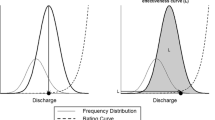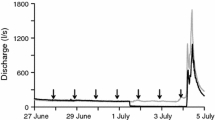Abstract
This paper evaluates an experimental environmental flow manipulation by modeling the counterfactual case that no environmental flow was applied. This is an alternate approach to evaluating the effect of an environmental flow intervention when a before-after or control-impact comparison is not possible. In this case, the flow manipulation is a minimum flow designed to prevent hypoxia in a weir on the low-gradient Broken Creek in south-eastern Australia. At low flows, low reaeration rates and high respiration rates associated with elevated organic matter loading in the weir pool can lead to a decline in dissolved oxygen concentrations with adverse consequences both for water chemistry and aquatic biota. Using a one dimensional oxygen balance model fitted to field measurements, this paper demonstrates that increased flow leads to increases in reaeration rates, presumably because of enhanced turbulence and hence mixing in the surface layers. By comparing the observed dissolved oxygen levels with the modeled counterfactual case, we show that the environmental flow was effective in preventing hypoxia.



Similar content being viewed by others
References
ANZECC (2000) Australian and New Zealand guidelines for fresh and marine water quality. Australian and New Zealand Environment and Conservation Council and Agriculture and Resource Management Council of Australia and New Zealand, Canberra, Australia, p 103
Aristegi L, Izagirre O, Elosegi A (2009) Comparison of several methods to calculate reaeration in streams, and their effects on estimation of metabolism. Hydrobiologia 635:113–124
Diaz JD (2001) Overview of hypoxia around the world. J Environ Qual 30:275–281
Dwyer GK, Stoffels RJ, Pridmore PA (2014) Morphology, metabolism and behaviour: responses of three fishes with different lifestyles to acute hypoxia. Freshw Biol 59:819–831
Fletcher AR, Morison AK, Hume DJ (1985) Effects of carp, Cyprinus carpio L., on communities of aquatic vegetation and turbidity of waterbodies in the lower Goulburn River basin. Mar Freshw Res 36:311–327
Grace MR, Giling DP, Hladyz S, Caron V, Thompson R (2015) Fast processing of diel oxygen curves: Estimating stream metabolism with BASE (Bayesian Single-station Estimation). Limnol Oceanogr 13(3):103–114
Gualtieri C, Doria GP (2008) Gas-transfer at unsheared free-surfaces. In: Gualtieri C, Mihailovic DT (eds) Fluid mechanics of environmental interfaces. CRC Press, Boca Raton
Gualtieri C, Gualtieri P (1999) Statistical analysis of reaeration rate in streams. Int. Agric. Engrg. Conf. (ICAE ‘99), Pechino, China
Gualtieri C, Gualtieri P, Doria PG (2002) Dimensional analysis of reaeration rate in streams. J Environ Eng ASCE 128:12–18
Gulliver JS (2011) Air-water mass transfer coefficients. In: Thibodeaux LJ, Mackay D (eds) Chemical Mass Transfer in the Environment. CRC Press, Boca Raton
Hladyz S, Watkins SC, Whitworth KL, Baldwin DS (2011) Flows and hypoxic blackwater events in managed ephemeral river channels. J Hydrol 401:117–125
Koehn J (2007) The loss of valuable Murray cod in fish kills: a science and management perspective. In: Lintermans, M., Phillips, B. (eds) Management of Murray Cod in the Murray-Darling Basin: Statement, Recommendations and Supporting Papers. Proceedings of a Workshop held in Canberra, ACT, 3–4 June 2005 Canberra. Murray-Darling Basin Commission and Cooperative Research Centre for Freshwater Ecology, pp 73–82
Mallin MA, Johnson VL, Ensign SH, MacPherson TA (2006) Eutrophication of Freshwater and Marine Ecosystems. Limnology and Oceanography 51(1):690–701
McCarthy B, Zukowski S, Whiterod N, Vilizzi L, Beesley L, King A (2014) Hypoxic blackwater event severely impacts Murray crayfish (Euastacus armatus) populations in the Murray River, Australia. Austral Ecol 39:491–500
Melching CS, Flores HE (1999) Reaeration equations derived from U.S. Geological Survey Database. J Environ Eng 125:407–414
Nilsson C, Malm Renöfält B (2008) Linking flow regime and water quality in rivers: a challenge to adaptive catchment management. Ecol Soc 13(2):18
Ning NSP, Petrie R, Gawne B, Nielsen DL, Rees GN (2015) Hypoxic blackwater events suppress the emergence of zooplankton from wetland sediments. Aquat Sci 77:221–230
Odum HT (1956) Primary production in flowing waters. Limnol Oceanogr 1:102–117
Oliver RL, Merrick CJ (2006) Partitioning of river metabolism identifies phytoplankton as a major contributor in the regulated Murray River (Australia). Freshw Biol 51:1131–1148
Parker GW, DeSimone LA (1992) Estimating reaeration coefficients for low-slope streams in Massachusetts and New York, 1985–1988, Water-Resources Investigation Report. U.S. Geological Survey
Rees G (2006) Ecological implications of azolla sp. proliferation events in the lower Broken Creek. Victoria. Report by the Murray-Darling Freshwater Research Centre, Wodonga, Australia
Rees G, Hall K, Baldwin D, Perryman SE (2007) The lower Broken Creek: aspects of water quality and growth of Azolla species Murray-Darling Freshwater Research Centre
Riley AJ, Dodds WK (2013) Whole-stream metabolism: strategies for measuring and modeling diel trends of dissolved oxygen. Freshw Sci 32:56–69
Sherman B, Webster IT, Jones GJ, Oliver RL (1998) Transitions between Aulacoseira and Anabaena dominance in a turbid river weir pool. Limnol Oceanogr 43:1902–1915
Skinner D (2012) Sediment resuspension and water quality during declining water levels in a shallow lake: a case study of Lake Alexandrina. University of South Australian, South Australia
Small K, Kopf RK, Watts RJ, Howitt J (2014) Hypoxia, blackwater and fish kills: experimental lethal oxygen thresholds in juvenile predatory lowland river fishes. PloS ONE 9:e94524
Stefan HG, Fang X (1993) Dissolved oxygen model for regional lake analysis. Ecol Modell 71:37–68
Stewardson M, Rutherfurd I (2008) Conceptual and mathematical modelling in river restoration: do we have unreasonable confidence? In: Darby SaS D (ed) River restoration: managing the uncertainty in restoring physical habitat. John Wiley & Sons Ltd, London, pp 61–78
Uehlinger U, Konig C, Reichert P (2000) Variability of photosynthesis-irradiance curves and ecosystem respiration in a small river. Freshw Biol 44:493–507
Vachon D, Prairie YT, Cole JJ (2010) The relationship between near-surface turbulence and gas transfer velocity in freshwater systems and its implications for floating chamber measurements of gas exchange. Limnol Oceanogr 55:1723–1732
Vervuren PJA, Blom CWPM, de Kroon H (2003) Extreme flooding events on the Rhine and the survival and distribution of riparian plant species. J Ecol 91:135–146
Walker KF, Thoms MC (1993) Environmental effects of flow regulation on the Lower River Murray, Australia. Regul River 8:103–119
Webb JA, Stewardson MJ, Koster WM (2010) Detecting ecological responses to flow variation using Bayesian hierarchical models. Freshw Biol 55:108–126
Whitworth KL, Kerr JL, Mosley LM, Conallin J, Hardwick L, Baldwin DS (2013) Options for managing hypoxic blackwater in river systems: case studies and framework. Environ Manag 52:837–850
Wilson GT, Macleod N (1974) A critical appraisal of empirical equations and models for the prediction of the coefficient of reaeration of deoxygenated water. Water Res 8:341–366
Acknowledgements
This research was supported by the Commonwealth Environmental Water Office, Australia and was undertaken as part of a broader environmental monitoring program led by the Murray Darling Freshwater Research Centre (MDFRC). The project was also supported by the Australian Research Council (Project DP130103619). The project benefited from advice provided by Dr. Gavin Rees (MDFRC) and Geoff Earl (Goulburn Broken Catchment Authority).
Author information
Authors and Affiliations
Corresponding author
Ethics declarations
Conflict of Interest
The authors declare that they have no competing interests.
Rights and permissions
About this article
Cite this article
Stewardson, M.J., Skinner, D. Evaluating Use of Environmental Flows to Aerate Streams by Modelling the Counterfactual Case. Environmental Management 61, 390–397 (2018). https://doi.org/10.1007/s00267-017-0955-8
Received:
Accepted:
Published:
Issue Date:
DOI: https://doi.org/10.1007/s00267-017-0955-8




